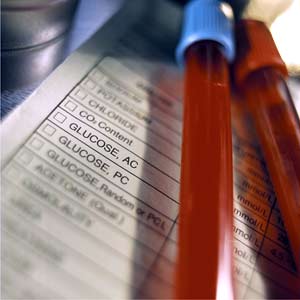Description of the test
The glucose tolerance test measures the body's ability to use glucose. Glucose is a type of sugar found in the blood.
Glucose levels, also called blood sugar levels, are regulated by the hormone insulin. When insulin works properly, blood sugar levels in the blood remain controlled. If insulin does not work properly or the body does not produce enough insulin, you may have diabetes.
The test is commonly used to diagnose medical conditions where the body cannot use glucose properly.
Testing can be done in a doctor's office, clinic, or hospital.
How often should the test be performed?
The test is routinely used during pregnancy to determine whether a woman has developed gestational diabetes (a temporary form of diabetes caused by pregnancy). It can also be used on a regular basis to screen people who are at risk of diabetes.
Why is this test performed?
This test is commonly used to diagnose medical conditions where the body cannot use glucose properly, such as prediabetes (where blood sugar is higher than normal, but not high enough for diabetes), diabetes, and gestational diabetes.
It also helps determine if you have another condition that affects blood glucose levels (e.g., Cushing's syndrome, celiac disease, cystic fibrosis, acromegaly, pheochromocytoma, hemochromatosis, Addison's disease, hypothyroidism, or cirrhosis).
Are there any risks and precautions?
Although the glucose tolerance test is considered safe, it does have some risk of side effects or complications. Though rare, the side effects or complications may include:
- infection, if the area is not properly sterilized before the sample is taken
- excess bleeding from the area that was punctured
- bruising and swelling where the needle was inserted
- feeling light-headed
You will be monitored throughout the test to make sure that your blood glucose level does not drop too low. You may experience weakness, sweating, anxiety, hunger, or other symptoms if this happens. Be sure to tell the person performing the test if you experience any of these symptoms.
People with bleeding disorders or anyone taking medication that reduces the ability of the blood to clot (e.g., warfarin, ASA, or other anticoagulants) should tell the technician before the samples of blood are taken. These conditions and medications may require special attention at the time of testing.
If you are concerned about any symptoms following this test, speak to your doctor. Take the time to be sure you understand all the risks of complications and side effects as well as any precautions you or your doctor can take to avoid them. Be sure your doctor understands all your concerns.
What happens during the test?
The test is usually done in a lab or your doctor's office. When you arrive for this test, if you are undergoing this test to screen for diabetes or prediabetes, you will have a blood sample taken to determine your fasting blood sugar. Then you will be asked to drink a sweet drink containing glucose. A blood sample will then be taken after 1 hour, and another after 2 hours. The blood samples may be collected at other time intervals, and your doctor may order additional blood samples to be taken if needed. The test can take up to 3 hours to complete.
In most cases, if you are being tested to screen for gestational diabetes, you will be asked to drink a sweet beverage when you arrive. A blood sample will be collected in approximately 1 hour. If the result of this test is abnormal, you may be asked to complete another test.
Blood is collected into small vials labelled with your information.
The technician will wear fresh latex gloves and use a new, single-use needle for each procedure.
To draw the blood sample, a technician or nurse wraps a wide elastic band around your upper arm to help locate the vein. Once the vein is located, usually on the inside of your elbow, the area is disinfected using alcohol swabs. The technician inserts a needle into a vein and pushes a vial onto the needle to collect the blood. The elastic band is then removed and after the blood is collected, the needle is removed and discarded. You will have to hold a small piece of cotton over the area until bleeding stops. A small bandage will be applied to hold the cotton in place.
The test is almost painless for most people, although you may feel a slight pinch when the needle is inserted.
How should I prepare for this test?
Before having this test, discuss the advantages, disadvantages, long-term risks, and consequences associated with the test with your doctor. Be sure you fully understand what will happen and are comfortable with your doctor's answers to your questions.
If you are undergoing this test to screen for diabetes or prediabetes, you should eat and drink normally for 3 days before the test, but do not eat or drink anything for at least 8 hours before the test. Follow any instructions provided to you by your doctor or health care professional.
Tell your doctor or prescriber about all prescription, over-the-counter (non-prescription), and herbal medications that you are taking. Also tell them about any medication allergies and medical conditions that you may have.
Ask your doctor or pharmacist whether you need to stop taking any of your medications before the test.
What can I expect after the test?
Some people experience slight bruising or tenderness where the needle entered the vein. Keep pressure on the area after the needle is removed to prevent bruising.
Results
Values for the level of blood glucose after the test are considered either lower than normal, normal, or higher than normal. Several conditions can cause higher-than-normal blood sugar levels.
For example, if you are pregnant and your results are higher than normal, you may have gestational diabetes. If you are not pregnant and your results are higher than normal, you may have diabetes.
Your doctor will interpret the results of this test in combination with other symptoms you may have. If your results are abnormal, your doctor may also recommend further testing.
All material copyright MediResource Inc. 1996 – 2024. Terms and conditions of use. The contents herein are for informational purposes only. Always seek the advice of your physician or other qualified health provider with any questions you may have regarding a medical condition. Source: www.medbroadcast.com/procedure/getprocedure/Glucose-Tolerance-Test


